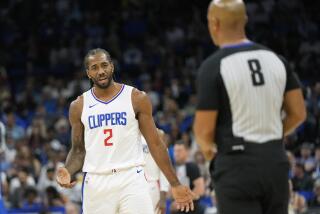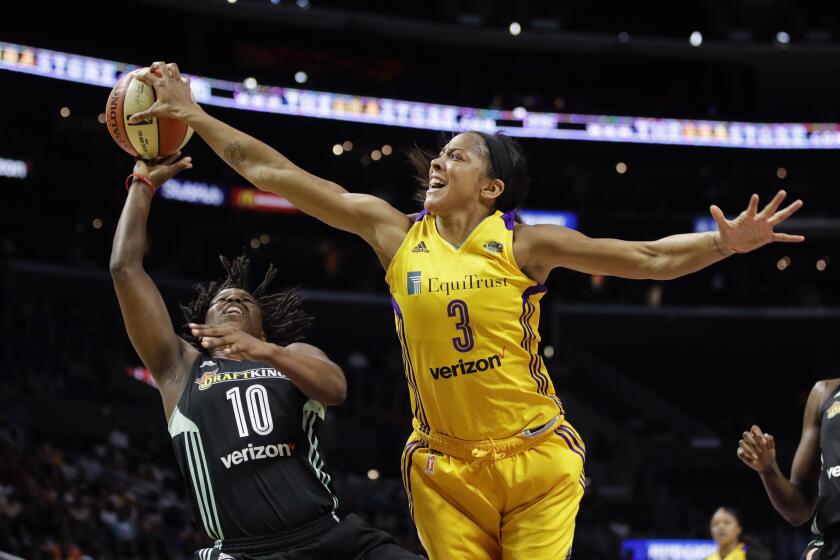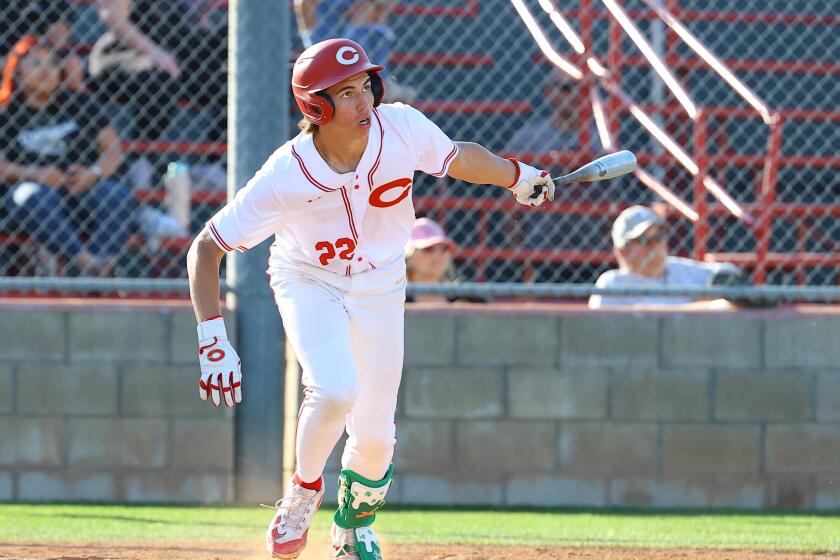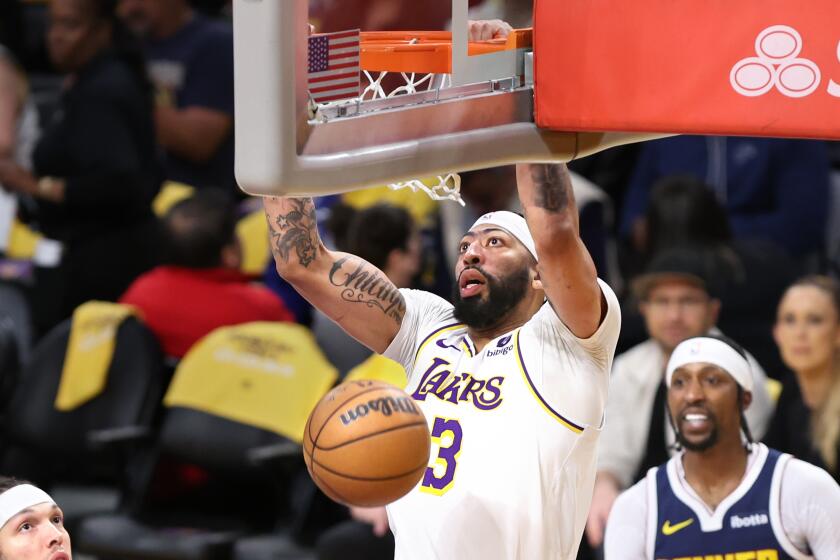The BCS? That Must Stand for Bowl Confusion System
College football is the only sport in which the best way to get questions answered about the bowl situation is to hire a contract lawyer.
It is the only sport where a team’s chances of going to a big-money bowl championship series game depend on what your definition of the word “or” is.
It is the only sport where Iowa calls the Rose Bowl to inquire about a clause that might keep the 11-1 Hawkeyes out of Pasadena and Notre Dame has to get back to you regarding a question that could involve a $13-million paycheck.
In baseball, you have clear-cut division champions and wild-cards entrants.
In pro basketball, eight teams from each conference make the playoffs.
In college basketball, 65 teams qualify for the tournament in an event so formatted you can print out the bracket on your home computer.
But in college football, “any team from a non-BCS conference or an independent institution, which is ranked three through six in the BCS standings, shall qualify for a guaranteed selection in one of the BCS games unless more than two teams meet this criteria. If one or more teams other than Notre Dame qualify for automatic selection, Notre Dame shall also qualify provided it is ranked in the top 10 in the BCS standings, or has a record of at least nine wins, not including exempted games.”
We’re just getting warmed up here.
In basketball, the anchor is usually your starting center.
In college football, the “anchor” is a school tied to a certain bowl by region.
Most sports measure strength of character; college football measures strength of schedule, calculated by quartile rank.
In basketball, a good point guard distributes the ball evenly to his teammates.
In college football, a good commissioner slowly reads to you a page in the media guide titled “2003 BCS Revenue Distribution.”
We have become so bogged down in this four-year-old BCS system, so mired in the minutiae, we view minor breakthroughs as the equivalent of the Salk vaccine.
Last weekend, we rejoiced when Miami and Ohio State emerged as the only two unbeaten teams because it was the first time all year reporters could type a definitive sentence regarding the championship race:
If Miami and Ohio State win out, the schools will meet for the BCS national title in the Jan. 3 Fiesta Bowl.
Of course, it will be that simple when Razorbacks fly, because one tiny toe-stub from Miami or Ohio State and then it is back to the BCS loony bin.
The BCS rule book has more provisions in it than a Donald Trump prenuptial agreement. Unfortunately, some of these convoluted clauses contain incredibly important information as it pertains to multimillion-dollar bowls and transportation plans for “Bevo,” the Texas Longhorns’ living bovine mascot.
For example, it came to light this week that Iowa, even if it finishes 11-1, could be denied a Rose Bowl berth because of two airtight clauses.
It was only natural to assume if the Rose Bowl lost Big Ten champion Ohio State to the Fiesta Bowl, it would happily take 11-1 Iowa as an at-large and keep intact its traditional Pac-10 vs. Big Ten partnership.
But that can’t happen if Texas and Notre Dame earn automatic at-large berths under BCS guidelines, the template used to place six major conference champions and two at-large teams in the BCS bowls: Rose, Sugar, Orange, Fiesta.
Texas can get one of the at-large spots by virtue of the “Kansas State Provision,” not to be confused with the Missouri Compromise or the Monroe Doctrine.
In 1998, Kansas State finished No. 3 in the first BCS standings after a gut-wrenching overtime loss to Texas A&M; in the Big 12 title game. Because all the major bowl bids had already been filled, Kansas State got knocked to the Alamo Bowl.
Wildcat fans coined a new phrase -- forget the Alamo.
The BCS decided that wasn’t fair, and amended rules to state any at-large team that finished third would be guaranteed a major bowl bid.
This week, Texas stands at No. 5 in the BCS and can’t win the Big 12 unless No. 4 Oklahoma stumbles down the stretch.
If Texas can navigate its way to No. 3 as an at-large candidate, it gets one of the bids. It also qualifies at No. 4 if the three teams ranked ahead of it are conference champions already designated for BCS bowls.
Notre Dame has special access to the BCS because 1) it’s the only major school not tied to a conference and 2) it has excellent lawyers.
It is written in the BCS rules Notre Dame will receive an automatic BCS berth so long as it is No. 6 or better in the final BCS standings.
This provision applies to “any team from a non-BCS conference or an independent institution,” and that would include the Irish.
The Irish are No. 7 this week in the BCS.
Notre Dame can be considered for a BCS game if it wins nine games and finishes in the BCS top 12.
To review, class, that’s an “or” for Notre Dame in the first provision but an “and” in the second.
Things could get interesting. The Orange Bowl is already talking about taking Notre Dame as an at-large pick if it loses “anchor” Miami to the Fiesta Bowl, assuming Miami finishes No. 1 in the BCS.
The Orange Bowl might also take 10-2 Notre Dame over USC, even if the Trojans finished 10-2 after defeating the Irish on Nov. 30.
USC’s only recourse in this case would be to beat Notre Dame so badly it knocked the Irish out of the BCS top 12.
And, really, besides the legal language, isn’t that what college football is all about?
Buck Stops
Ohio State (11-0) needs two wins to finish 13-0 and advance to the Fiesta Bowl, where the Buckeyes would be seeking to win their first national title since 1968.
But here’s the question: Which of the two remaining games is going to be tougher for Ohio State, at 4-6 Illinois this week or home to 8-2 Michigan on Nov. 23?
We’re not so sure it won’t be Illinois, which has won three of its last four games.
Reason: Ohio State has been a mediocre road team this year, beating four opponents by an average score of 19.75 to 13.75. The Buckeyes needed to intercept a pass in the end zone to preserve a 23-19 win over Cincinnati, trailed lowly Northwestern at the half in Evanston on Oct. 5 and required a fourth-down touchdown pass last week to win by four at Purdue.
“We’ve weathered some storms on the road,” Buckeye Coach Jim Tressel said. “We do fully understand we need to play better on the road this week.”
At home, Ohio State has won seven games by an average score of 37.57 to 10.57.
Obviously, the Buckeyes had best not look past Illinois toward Michigan. That kind of oversight this year could cost Ohio State the national title.
Hurry-Up Offense
How did Washington State jump from No. 5 to No. 3 in this week’s BCS standings? The Cougars picked up only 1.5 points in their poll average, but shaved 2.66 points from their computer component average. The computer aspect of the BCS remains the biggest mystery. Washington State moved up only one spot, from eighth to seventh, in Richard Billingsley’s rankings but jumped five spots, from ninth to fourth, in the New York Times’ computer. Those are fairly interesting interpretations, this late in the season, over the same team after a win over Oregon.
The New York Times also has USC at No. 3, meaning the Trojans are ranked only one position lower (3) than the team has defeats (2). None of the other six computers has USC ranked better than No. 8.
You may or may not have heard of the new front-runner in the Heisman Trophy race. He is Miami sophomore tailback Willis McGahee, who overtook teammate Ken Dorsey in this week’s Rocky Mountain News poll. The newspaper has for the last 16 years solicited weekly Heisman picks from 10 writers from across the nation.
Colorado Coach Gary Barnett, during a Monday conference call, ripped the lack of Heisman attention for Chris Brown, his star tailback. “Guys at ESPN have more control over who wins the Heisman than anybody else,” Barnett said. “They’re the ones who talk about it all the time.” Contrary to Barnett’s rant, Brown is in the Heisman hunt, tied for third with Marshall quarterback Byron Leftwich in this week’s Rocky Mountain News poll. Iowa quarterback Brad Banks is fifth in the survey, while USC’s Carson Palmer and Jason Gesser of Washington State are also receiving votes.
North Texas made news last year when it finished 5-6 and still advanced to the New Orleans Bowl, ending the season at 5-7 after a loss to Colorado State. Well, the Mean Green is at it again, 5-5 overall with a chance to win the Sun Belt Conference title and advance to the New Orleans Bowl with another nonwinning season. North Texas, 4-0 in conference play, faces 4-0 New Mexico State in this week’s battle for first place. If North Texas wins this week and loses the following week to Middle Tennessee State, and New Mexico State loses its last two, the Mean Green could capture the Sun Belt title with a 6-6 overall record.
New Mexico State is already bowl eligible at 6-4 and is trying to break the nation’s longest bowl drought streak, having last appeared in a postseason game at the 1960 Sun Bowl. Tony Samuel, the current head coach, was 5 years old.
Fair or foul? While several one-loss teams can expect to get the BCS shaft, three-loss Florida State is closing in on the Atlantic Coast Conference title, which would earn the Seminoles an automatic BCS bowl berth, likely the Sugar. Florida State can all but clinch the ACC with a win over North Carolina this weekend and could still get a BCS bid even if it lost its last two games and finished 8-5.
More to Read
Get our high school sports newsletter
Prep Rally is devoted to the SoCal high school sports experience, bringing you scores, stories and a behind-the-scenes look at what makes prep sports so popular.
You may occasionally receive promotional content from the Los Angeles Times.







